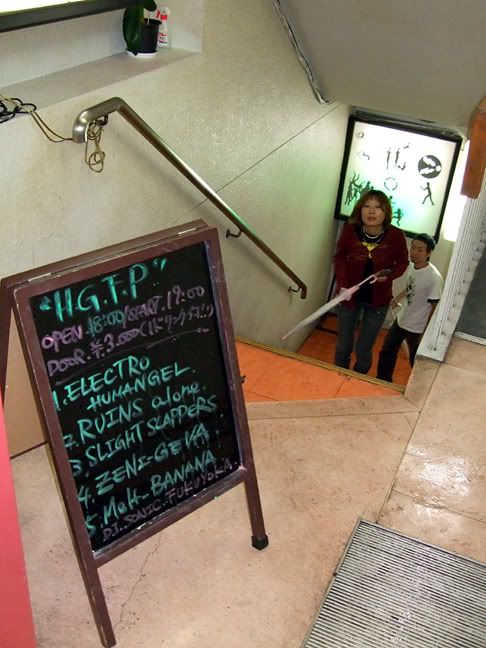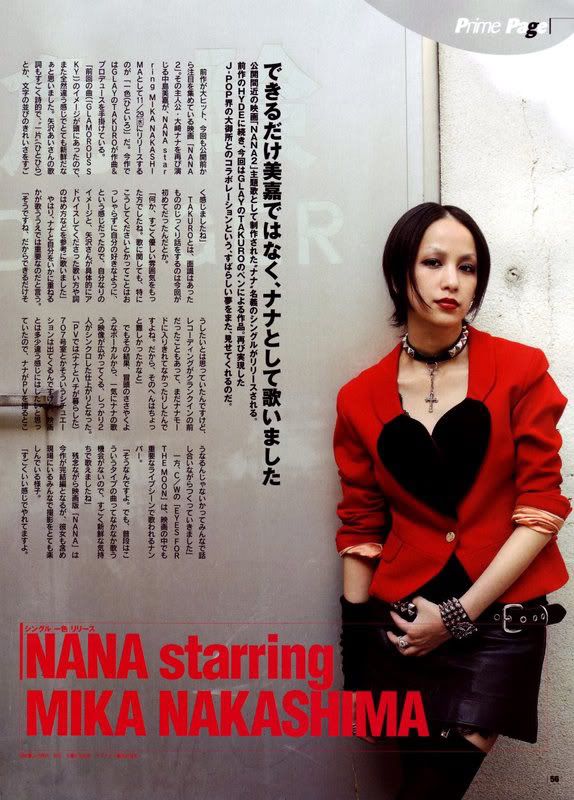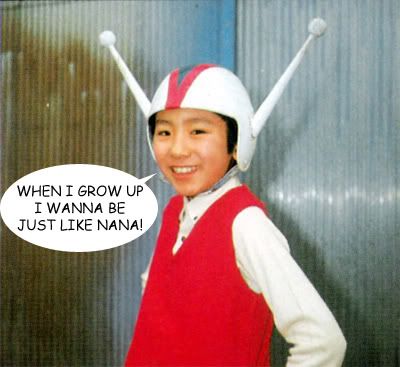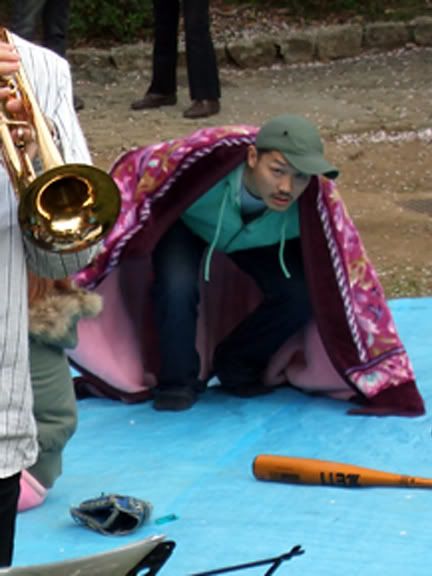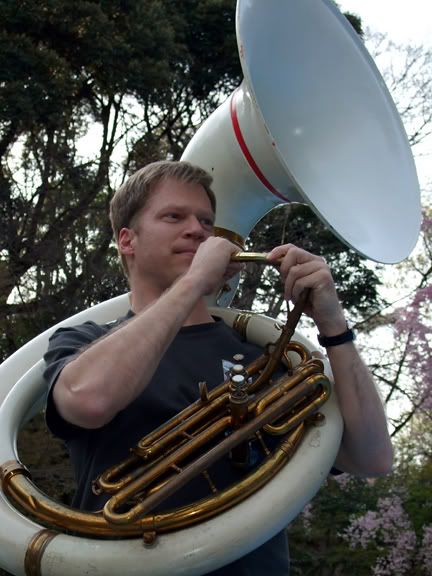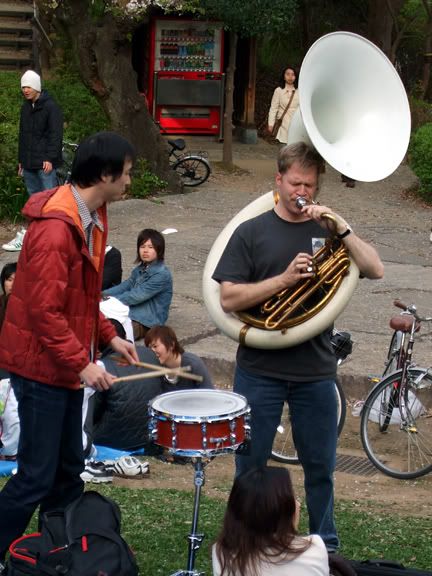Wednesday, May 28, 2008
Japanese Ghost Stories from Peter Payne!
Do you know the story of Toire no Hanako-san, or Miss Hanako of the Toilet? It's a Japanese urban legend that can be found at most every elementary school here, and it goes like this: if you go to the fourth stall of a specified girl's bathroom, usually on the third floor of the school, knock three times and call out "Hanako-san, are you there?" then you'll hear her reply, "Hai" (yes). Open the stall and you'll see a shimmering figure of a girl with bobbed hair with a red skirt on standing there. It's the ghost of Hanako, a girl who committed suicide after being bullied by her classmates (ijime), who is said to haunt the girl's bathroom looking for revenge. Or in an older version, Hanako is a girl who was playing hide-and-seek in the school bathroom during the war and was killed in an American air raid because she couldn't hear the air raid siren.
Three junior high school students of mine related this story in class one day. Their version didn't include Hanako's physical description but was otherwise identical. Also, in their telling, Hanako-san is the bully victim. Bullying has a lot more currency these days than American air raids. And of course, they don't believe it any more than American teens believe in Bloody Mary or the Lover's Lane Hook.
Here are some more Japanese urban legends from Peter Payne:
Hanako-san is part of a pantheon of "school ghost" stories that are well known in Japan, like Kuchisake Onna or Split-Faced Woman, a female ghost who asks you if she's beautiful before trying to devour you, and Teke-Teke, the upper torso of a female who claws her way around Japan searching for her lower half, which was severed in a train accident in Hokkaido. Anyone hearing this story will supposedly see Teke-Teke's lower half walking aimlessly around the countryside within three days. Let us know if you see anything!
They told me about Kuchisake Onna. What would you say to her if she asked you that question? And don't worry- I doubt Teke-Teke's legs are going to cross the Pacific Ocean to show up in Athens or Albany to terrify anyone... but who knows? Maybe that's why she can't find them!
I love this stuff. Ever since I read my first book of urban legends. Or maybe it was the Halloween episode of Real People featuring the "true" ghost stories. Anyway, make sure you click on the J-List blog link. You have to scroll down a little, but it's worth it because you can see a couple of artist's interpretations of poor Miss Hanako.
Tuesday, May 27, 2008
A sure-fire method for boosting tourism...
Saturday, May 24, 2008
The 5678s...
Courtesy of some helpful soul on YouTube, it's the band Quentin Tarantino featured in the first Kill Bill movie, the 5678s. They're a Japanese garage rock/rockabilly/surf trio with a stripped-down sound and they've been on the scene since 1986.
I wish I could say I was into them ahead of the Kill Bill wave, but no. Not that cool. But I wasn't even thinking that much of them until one day back in 2004 when I was upstairs in a now-defunct punk cd and vinyl shop here and found a compilation of theirs, Bomb the Rocks- Early Days Singles. It features essential tracks like their cover of "Woo Hoo," the awesome "Three Cool Chicks" (complete with spoken middle section), "Jet Coaster," "Guitar Date," "My Boyfriend From Outer Space" and the stunningly titled-and-performed "I Was a Teenage Cave Woman." Just about the only track you don't get is "I Walk Like Jayne Mansfield," a singular omission.
On look at the cartoony cover, with the band smilingly facing off against zombie motorcyclists in WWI German helmets and I knew I had to have it, Kill Bill and Vonage commercials be damned!
If you like high energy, retro styling, raw screaming and twangy surf-style guitar, then you'll probably love this. Even if you're (like me) not particularly a Quentin Tarantino fan.
It's a boring, rainy Saturday in Hamamatsu. Today's tasks included ripping the door off my closet while trying to prepare a workspace so I can get back into drawing in my spare time. What does the closet door have to do with drawing, and why did I destroy it? I'm still trying to figure that one out.
But it's fixed now, and I managed not to crush any of my bare toes while doing it. And my drawing area is all set up and ready to go. I really need an angled drawing table with an incandescent light, but that's not going to happen in this tiny apartment. So I'm making do with a kidney-shaped coffee table and a pillow on the floor. If the rain ever stops, I'll go buy a tracing light that'll provide the angle I need to keep distortions out of my work.
Other than the ones my own incompetence creates.
I'm learning how to draw some of John Kricfalusi's characters. Not that I have a chance of working for him, but he's been putting up a lot of turn-arounds and story sketches and challenging talented young artists and professionals to audition for the new cartoons he's producing. Lemme tell ya- it ain't easy. I've seen some of the submissions and there are some talented cats and kittens out there and even most of those don't have what it takes to function in the rarefied Kricfalusisphere where the Sputniks beep.
So for me, it's just a personal exercise. I'm also doing some illustrations of my own and piddling with ideas for a couple of comics. I'm really thinking I'd rather just design the characters, write the scripts, provide some rough layouts, maybe draw the covers then let someone else more capable do the actual finished story artwork. I'd have to find a person with a similar set of aesthetics as mine, who's willing to actually put out the pages. I'm not sure how the rights and all that stuff are supposed to be split. I've got scripts for the initial 2 issues written already, outlines for several more and the first 5 pages of the first roughed out pretty solidly... one more pass and the pencils are done... but not enough steampower to write and draw everything myself.
So I don't know how that'll work out.
Also, now that I have a workspace I can get back to editing the 6 short stories I've written. To this end, I had to kill one of my blogs, and I'm not certain how regularly I'll be updating this one. Hope it was worth it.
Wednesday, May 21, 2008
"Nana volume 4:" a Japanese Comic Review!
 Nana vol. 4
Nana vol. 4Publisher: Shojo Beat/Viz Media
Writer/Artist: Yazawa Ai
English Adaptation: Allison Wolfe
Translation: Goto Koji
Let me tell you right now the outfit that Sachiko wears in scene where she inadvertently faces off with Hachi outside the restaurant where she and Hachi’s boyfriend Shoji work just absolutely kills me! What is that… some kind of fleece Alpine bonnet? With dangling puffballs? And her backpack matches her full-length skirt; obviously, she made both of them herself… she’s a fashionista with a pixie cut!
Sorry, I have a weakness.
On a cold night, Nana Osaki keeps her hapless-in-love friend Nana company as they wait in the parking lot outside for Shoji to get off work. Hachi learns Nana is from some frigid prefecture where snow is common, and listens as her punk friend sings some soft song to the night….
That’s when Yazawa Ai brings Hachi, Shoji and Sachiko together for a tearful confrontation where the painful truth emerges. The build-up is exquisite, as is the payoff. Nana sticks up for her friend, ready to pound the two-timing Shoji right in the face with one of her ring-laden fists. And Hachi? She’s the one who’s been betrayed, and this after waiting a whole year, saving every yen for the move, sacrificing everything to live her dream for both of them. How does she react?
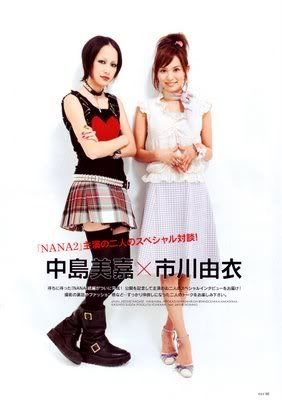
Nana volume 4 is like an emotional elevator for Hachi and the hapless readers. Up- Hachi’s growing fascination with Nana. Down- Shoji. Up- tickets front row center for a Trapnest concert in her hometown. Down- no one to go with. Up- Black Stones’ first Tokyo show. Down- Nana’s gosu-rori groupie Misato.
The middle section depicts the show itself, and Yazawa throws in a lot of little reportorial details. The place only holds a limited number of standing-room-only bodies, the cover includes a ticket for a free drink. I once ordered a Coke at one of these shows and the bartender looked at me like she’d just met Forrest Gump live and in person. Oh yeah, I’ve been to quite a few shows here in Japan; only we don’t call them “shows” or “concerts” here. The preferred term is “live.” You might tell a friend the next day, “I went to Black Stones’ live last night.”
“Where was it?”
“At the live house.”
Doyyyyy…
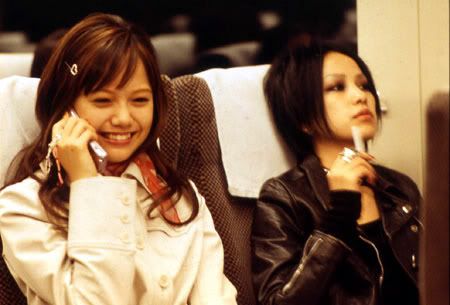 The show takes place in a small venue somewhere in Shinjuku (Check out local landmark, the Epson building, as Junko and Kyosuke drive past on their way to the show). After the first band, the crowd’s ready to split, but Hachi and Misato (in sausage roll hair, her floral and petticoated skirt and knee-socks, she looks like a living doll) perform a little impromptu sketch:
The show takes place in a small venue somewhere in Shinjuku (Check out local landmark, the Epson building, as Junko and Kyosuke drive past on their way to the show). After the first band, the crowd’s ready to split, but Hachi and Misato (in sausage roll hair, her floral and petticoated skirt and knee-socks, she looks like a living doll) perform a little impromptu sketch:Hachi: Ya wanna know what? This next band is, like, the best band in the world!
Misato (shouting): I totally agree! Doesn’t Blast just totally rule?! The singer, Nana, is amazing! Her voice is so strong and beautiful!
Their interest piqued, a few curious onlookers filter back into the live house. Yazawa makes even the extras stand out. There’s the tall girl in the spiky, modified-ducktail haircut and star print tee who wants to know if the band’s all girls, her friend in the plaid beret, the buzz cut dude wearing a slick motorcycle jacket and his pal with the rolled-up sleeves and sweatband on his wrist. Everyone seems to be fully accessorized. It must be a blast for her to come up with these distinct and accurate hipster looks. I’ve seen these people! At lives!
And then Blast takes the stage, Nana tying a rose to the mic stand.
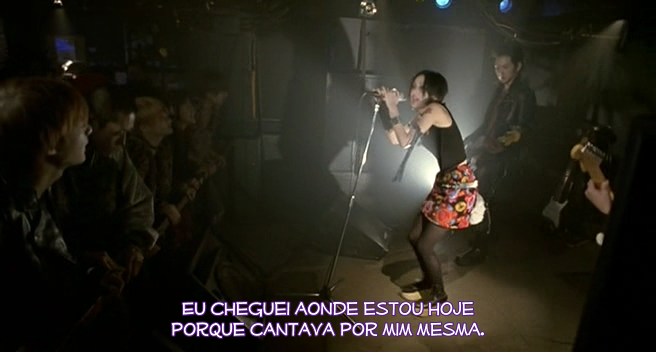 There's even a chance the show might've taken place in Shin-Okubo, a neighborhood just a stop from Shinjuku on the Yamanote Line. It's certainly close enough for Junko and Kyosuke to drive there, and there are a few live houses just outside the station within easy walking distance. In fact... here's one now. You've seen the Nana version of a live show in Japan, now here's the real thing. Melt-Banana at Earthdom, September 2007:
There's even a chance the show might've taken place in Shin-Okubo, a neighborhood just a stop from Shinjuku on the Yamanote Line. It's certainly close enough for Junko and Kyosuke to drive there, and there are a few live houses just outside the station within easy walking distance. In fact... here's one now. You've seen the Nana version of a live show in Japan, now here's the real thing. Melt-Banana at Earthdom, September 2007:
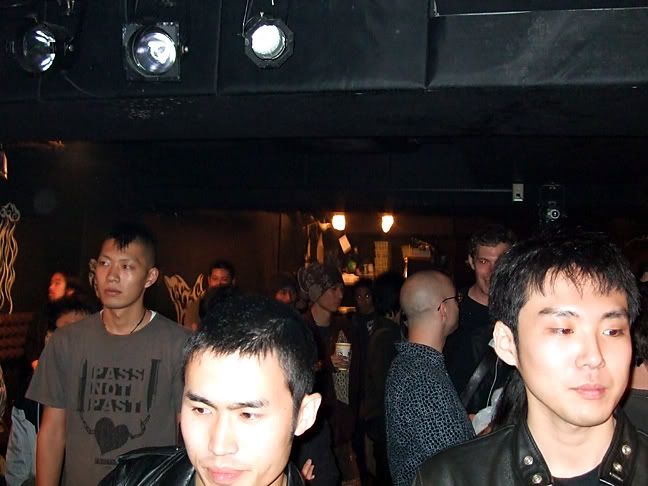

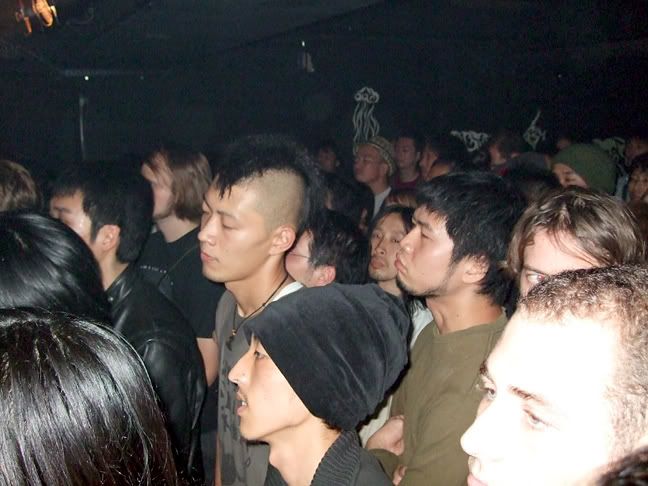
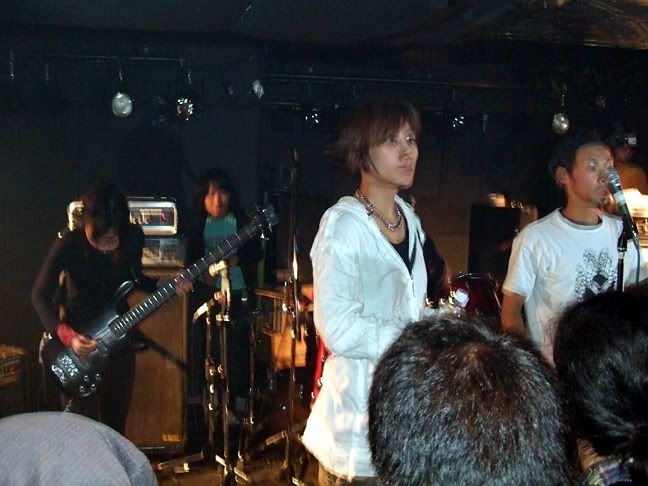
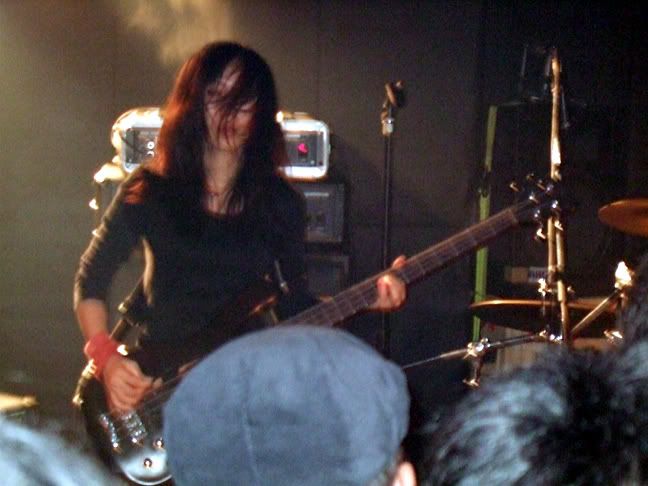
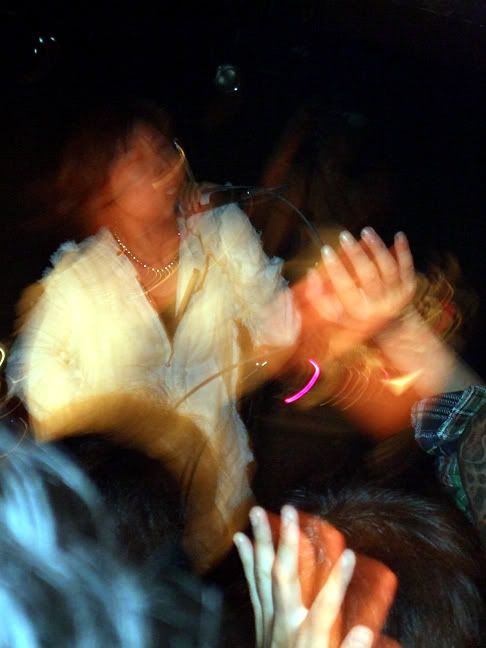 What it lacked in Nana-like elegance and fashionability, it more than made up for in energy and power. Melt-Banana's total sonic attack destroyed eardrums and the crowd moshed with frantic intensity. I ended up hobbled like an oldster, leaning on my umbrella as if it were a cane, my body sore, but my heart soaring. Welcome to my world!
What it lacked in Nana-like elegance and fashionability, it more than made up for in energy and power. Melt-Banana's total sonic attack destroyed eardrums and the crowd moshed with frantic intensity. I ended up hobbled like an oldster, leaning on my umbrella as if it were a cane, my body sore, but my heart soaring. Welcome to my world!That’s at least one of the many ways this book gets its addictive hooks in you- presenting the familiar and the ultra-dramatic side-by-side. Like the semi-similar Love & Rockets, Nana presents a heightened reality filled with situations that are similar to things you’ve been through, only amplified for fictional effect. Nana is an unrepentant soap opera, in comics form. And that Yazawa Ai is a fiend. Pure evil, I tells ya! She created these characters, all the cute girls and pretty boys, put them in a fun milieu and set them into motion with Nana and Hachi as the story’s beating, bleeding, loving hearts, their every action creating emotional chaos, making the readers want more, more, MORE.
Pure wickedness.
"Nana volume 3:" A Japanese Comic Review!
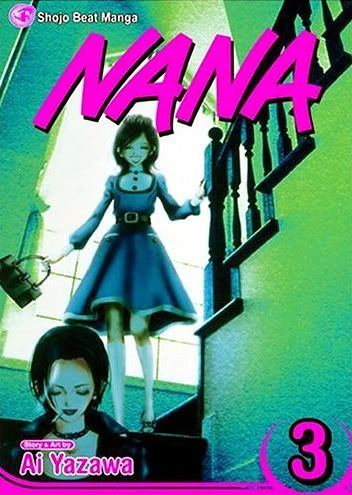 Nana vol. 3
Nana vol. 3Publisher: Shojo Beat/Viz Media
Writer/Artist: Yazawa Ai
English Adaptation: Allison Wolfe
Translation: Goto Koji
Is apartment 707 cursed? And who was killed there and just how did this bloody murder go down? Nana O, relaxing in her bubble bath with a cigarette would certainly like to know, and a freaked out Hachi would love to tell her- if only she could stay on topic and stop digressing into speculation about Ms. Yamada's gruesomely old and wrinkly love life...
Oh, never mind- it’s just Hachi’s (the comic character formerly known as Nana Komatsu) imagination running away with her again. You know, like when she talks about the Demon Lord who’s intent on destroying her and her boyfriend Shoji’s secret lover, Sachiko. Even Shoji plays along with the last one; it’s one of Hachi’s adorable personality quirks that she invents imaginary people from time to time.
Yeah, that Hachi is a quirky person all right. She’s flighty, insecure, energetic, outgoing and loyal, especially where her new friend Nana Osaki is concerned. When Nana’s ol’ bandmate Nobu hits town and the two put on an impromptu concert in the apartment, Hachi’s smitten with the idea they should form a new group and challenge rock stars Trapnest for musical supremacy. She’s also obsessively reflective and secretly picks apart her self-perceived flaws mercilessly. After sending Shoji one too many text messages, she lambastes herself as a selfish jerk…
Then it turns out there really is a girl named Sachiko. And if anything, she’s even cuter than Hachi. She just started working at the Denny’s-like restaurant where Shoji’s employed. Hachi’d better watch out!
Volume three of Yazawa Ai’s ongoing comic series about two disparate young women on the loose in the urban wilds of Tokyo starts turning the drama volume knob up on the Marshall stack that is Nana-life. Lost jobs, mysterious bald lawyers with multiple ear-piercings, potential extracurricular love interests, new jobs that flat-out suck due to imperious office seniors. And just when everything was going so well for the girls.
 Well, it wouldn’t be drama or even a story without conflict. Nana’s conflicts are rarely the physical kind. No one’s ever trapped in a burning building… wait! No one’s trapped in a burning building are they? Are the Nanas safe? Because that would be too much… Whew! That’s what becoming a Nana addict does to you.
Well, it wouldn’t be drama or even a story without conflict. Nana’s conflicts are rarely the physical kind. No one’s ever trapped in a burning building… wait! No one’s trapped in a burning building are they? Are the Nanas safe? Because that would be too much… Whew! That’s what becoming a Nana addict does to you.
You start staying up late nights worrying about Nana and Hachi, about Shoji and Sachiko. The only people you don’t worry about are Junko and Kyosuke; they’re too self-possessed and rock steady to cause concern. In fact, they’re so together Kyosuke can talk freely about the past love who broke his heart and all Junko will do is laugh at his pain and tell him, “Nice teen years, dude.”
Junko and Kyosuke are cool, but if Yazawa had to write a series about their lives, it'd be pretty snoozeworthy and wouldn't inspire film adaptations, like the two Nana flicks, starring Nakashima Mika:
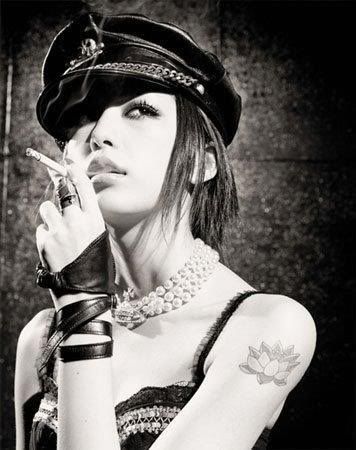 Huh. That still looks like something out of the Sin City movie. Some enterprising Frank Miller fan could add some spot red on Nakashima's lips there. Feel free, Miller fans! But I'll stick with Nana.
Huh. That still looks like something out of the Sin City movie. Some enterprising Frank Miller fan could add some spot red on Nakashima's lips there. Feel free, Miller fans! But I'll stick with Nana.
A true master of delicious character (and reader) torture, no sooner does Yazawa establish a status quo than she starts tearing it (and our souls) apart. Not just with the appearance of Sachiko, but the also the joining of the cast of Shin, the underage kid with a string of lovers that would be the envy of a Lothario twice his age and further developments in Nana’s and Hachi’s growing platonic love affair. Some of the plot points you can spot before the characters do- calculatedly fascinating nonetheless, perhaps even more so because of the “slow motion train wreck” aspect- others are more surprising.
And her art continues to grow on me. I’m not so sure the gray-toned photo backgrounds work every time, but we’re not here for a Tokyo travelogue. With the plots growing primarily out of the character’s choices and decisions, internal and external conflicts (the emotional kind), the elegant, angular figure-drawing carries the story visually rather than the settings. Not that Yazawa doesn’t give a sense of place; after all, apartment 707 is almost a character in itself, and the stylish fashion-plate Nanas need equally fashion-forward environments in which to love and hate. That's where Jackson Hole (home of the Jackson Burger- Hachi swears by them) and Sabrina, the funktacular vintage store where Nana finds her first Tokyo job, come in.
As I’ve written in my previous reviews, one of my favorite aspect of Yazawa’s artwork is the specificity of outfits. I’m a huge fan of Japanese street style, and I’m always buying FRUiTS, CUTiE (it's for independent girls!) and sometimes even Zipper magazines to check out the latest fashion trends here. I mean, you can’t always take a trip to Shibuya, Harajuku or Omotesando, so you have to absorb this stuff somehow!
Here's Nakashima Mika in full-on Nana regalia: Nana Osaki sports rocker chick-wear, possibly from Black Peace Now, the gothic and Lolita fashion line you find in punk/goth boutiques all over; it's infinitely cooler than anything at Hot Topic and ten times more expensive. Or maybe some smaller shop, like the punk store I found just off Takeshita-dori a few years back. The name escapes me (it was something like "Up Yours!" or "Fuck Off, You Bastards!" or "Sit on it, Fonzie!" or something equally outre... I'll go back someday and take some photos and the name won't be anything like that and I'll be embarrassed), but they had Wehrmacht caps for punks intent on giving straight society the finger. Nana's usually dressed in lots of black, visible bra straps, plaid asymmetrical miniskirts, heavy engineer boots and her signature piece, the zippered motorcycle jacket.
Nana Osaki sports rocker chick-wear, possibly from Black Peace Now, the gothic and Lolita fashion line you find in punk/goth boutiques all over; it's infinitely cooler than anything at Hot Topic and ten times more expensive. Or maybe some smaller shop, like the punk store I found just off Takeshita-dori a few years back. The name escapes me (it was something like "Up Yours!" or "Fuck Off, You Bastards!" or "Sit on it, Fonzie!" or something equally outre... I'll go back someday and take some photos and the name won't be anything like that and I'll be embarrassed), but they had Wehrmacht caps for punks intent on giving straight society the finger. Nana's usually dressed in lots of black, visible bra straps, plaid asymmetrical miniskirts, heavy engineer boots and her signature piece, the zippered motorcycle jacket.
Hachi is sort of hime-gyaru, “princess girl,” a femmy look usually sported by women in their late teens or early 20s. It’s like big sister to the gyaru style bursting out of the 109 building in Shibuya. Check out her belted blue dress on the comic’s cover- vaguely 50s style, sort of timeless but with the cutesy touches of knee socks and open-toed pumps with high heels. And then there are the Blast boys, wearing creepers while they back Nana musically during their practices. No matter which character, Yazawa’s art must be a boon to cosplayers.
In the bonus story, “Junko’s Place,” Yazawa continues to blend the supporting cast as bald cat Yasu and the androgynous Nobu visit Hachi’s friend at her snack bar, only to find it’s closed. Ambitious gal, that Junko. Probably working another job or guest starring in another comic for some extra bucks or something.
And here's a bonus for you- movie Nana Nakashima Mika singing her 2007 hit, "Life," the theme song to a TV drama adaptation of another comic series called... Life. Probably launching a billion late night drunken karaoke renditions, although many of the people I know pop in to sing a few songs in the middle of the day:
Yazawa Ai is my own Demon Lord... Demon Lady... she has me hooked on this series, hooked madly. I haven't fallen this hard for a comic since the day I picked up Love & Rockets on a whim. In fact, there's a superficial similarity between the soap opera-ish doings in Nana and those in Love & Rockets. You know, two young women living their lives, some punk rock and... er... there it pretty much ends.
PS- Nana cosplay is pretty popular. Here is a link to a couple of Taiwanese girls doing just about the best Nana/Hachi duo I've seen. See? Yazawa's specificity of costuming makes it easy!
HIGHLY RECOMMENDED
"Nana volume 2:" a Japanese Comic Review!
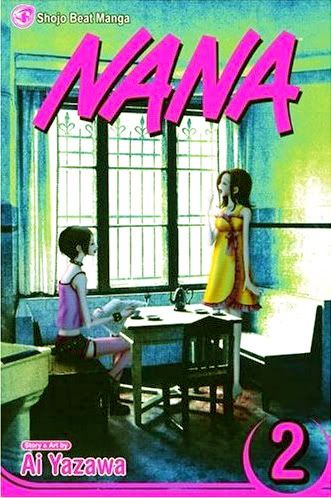 Nana vol. 2
Nana vol. 2Publisher: Shojo Beat/Viz Media
Writer/Artist: Yazawa Ai
English Adaptation: Allison Wolfe
Translation: Goto Koji
What happens when one girl named Nana meets another girl named Nana? Will physics allow two Nanas to occupy virtually the same physical space, or will the universe die screaming as anti-matter and matter collide, ripping apart the space-time continuum? Actually, all potential problems are solved when punk Nana Osaki notices girly Nana Komatsu’s personality resemblance to a famous dog and renames her friend Hachi. Thus reducing the Nana surplus by one and saving reality as we know it.
The fun starts when Shoji, Nana K’s long distance boyfriend, sends her a special text message: “Cherry blossoms R blooming!” and tells her he finally got into art school. So she quits her video store job, runs through the snow in her monster lace-up platform boots, jumps the shinkansen for Tokyo for their long-awaited reunion. She’s saved her money, waited ever so patiently and now all her dreams are coming true…
If only Nana K can be patient for a few hours more. The shinkansen’s delayed due to snow and there’s only one empty seat- empty but for a sinister looking black guitar case guarding the sleeping girl in the window seat next to it. This girl is nothing like Nana K; she’s all dressed up in black, looks like an erotic vulture in her leather jacket, thigh-high fishnets and clunky engineer boots.
Nana K’s decision to take the seat changes both of their lives. And her name!
You know, with the comic series emerging as one of Japan's top-selling titles of all time and the 2005 film adaptation spawning even more Nanamania, a sequel became inevitable:
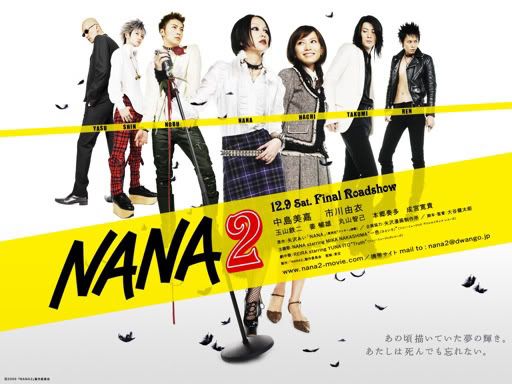 Nana 2 debuted in 2006. Again, Nakashima Mika starred as Nana O, the fame hungry punk rocker. But Miyazaki Aoi didn't reprise her role as Hachi. Why? What do I look like, Japan Film Insider? Whatever the reason, Ichikawa Yui took over the role. The sequel wasn't as big a hit as the first, and a few people I've talked to about it recently expressed their disappointment with both movies, and their preference for the animated series. Oh well, at least Nose Anna returned as Junko!
Nana 2 debuted in 2006. Again, Nakashima Mika starred as Nana O, the fame hungry punk rocker. But Miyazaki Aoi didn't reprise her role as Hachi. Why? What do I look like, Japan Film Insider? Whatever the reason, Ichikawa Yui took over the role. The sequel wasn't as big a hit as the first, and a few people I've talked to about it recently expressed their disappointment with both movies, and their preference for the animated series. Oh well, at least Nose Anna returned as Junko!
Anyway, back to the comic review.
And so Yazawa Ai finally brings our two Nanas together, on a snowbound train aimed at Tokyo. Through various circumstances and perhaps the machinations of Nana K's personal deity/devil the Demon Lord, the girls end up as roommates in a funky Tokyo suburb along what I’m guessing is the Sumida River. I base this on my own scientific Nana research, consisting of going to Tokyo and looking for a river. I wanted to go to Kojima-cho to look for Jackson Hole and have a Jackson Burger (Hachi's favorite food), but a nasty cold and frequent chilly downpours caused me to limit myself merely to reading about it, and having Wendy's in Shibuya instead.
Yazawa also begins weaving together the supporting casts. At first it seemed as though we were going to be treated to parallel narratives but Yazawa skillfully mixes the very different characters to create dramatic tension and humor.
Nana K’s impulsive nature comes to the fore as she falls head over heels in platonic love with her slightly sinister, definitely mysterious doppelganger. If fate and coincidence are to be recurring themes, then it certainly seems that Nana K’s intuition serves her well. Because the story cannot happen unless she appends herself to Nana O’s life, works her way into the center despite their differing backgrounds and outlooks. Failing that, both characters and all their friends would be out of work and they'd end up hanging around Junko's snack bar all day. And we would have nothing to read.
Nana K is a reckless romantic, while Nana O is coolly self-possessed. But how will her punk rock façade hold up when living with a girl who loves Trapnest, the very band her own lover abandoned her to join (to the point of adorning their shared pad with a massive fannish poster of the group)… with her love crazed, puppydog-like-in-her-clumsy-enthusiasm roomie? That’s the origin of the name Hachi.
Hachiko was a dog who waited at Shibuya Station every day for her college professor owner even after he died. A symbol of loyalty, she’s immortalized in a statue outside the station, and the exit to that area is named after her: the Hachiko Exit. People say if you stand there long enough, the one you’d most like to see will eventually walk by. You can speed up the process by simply text messaging that person and arranging a rendezvous beforehand. But given the mob usually lounging around the Hachiko statue, you should probably wave a flag.
Nana, meet Hachi, your very own loyal, loving pet girl friend.
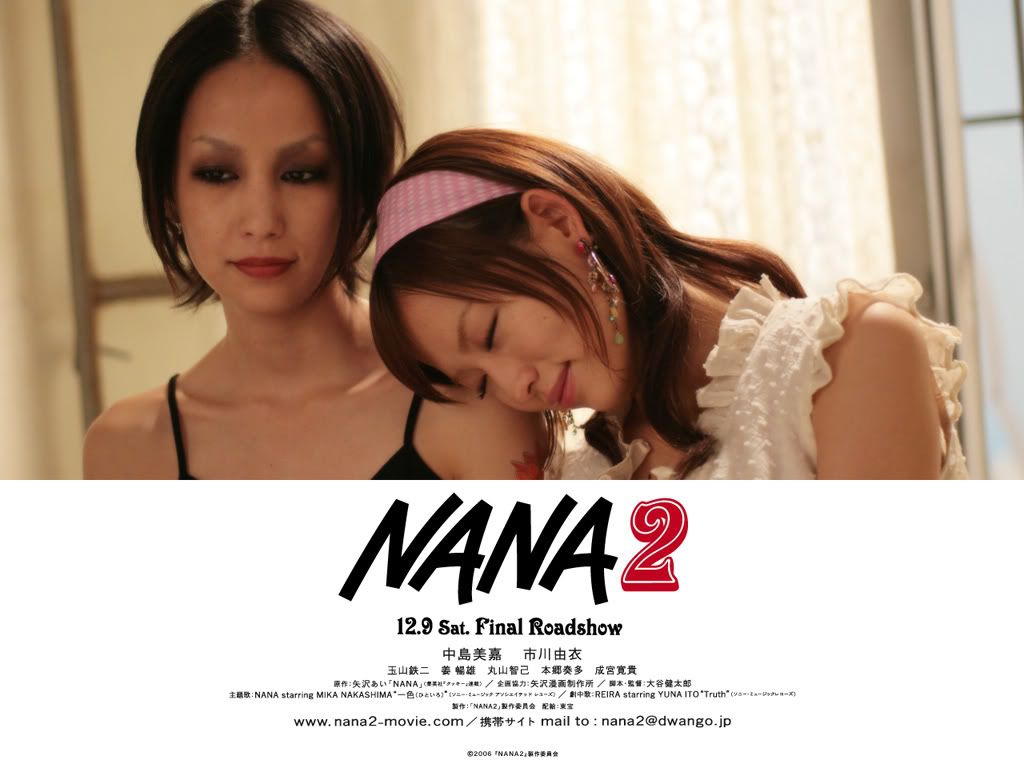 I think we can all agree Nakashima Mika is perfect as Nana O. She's also a big-time singing star in her own right, and released an album called The End: Nana starring Mika Nakashima that features her songs from the second film. Her comics connection continues- last fall she had a hit song with the theme to the TV drama adaptation of the comic Life.
I think we can all agree Nakashima Mika is perfect as Nana O. She's also a big-time singing star in her own right, and released an album called The End: Nana starring Mika Nakashima that features her songs from the second film. Her comics connection continues- last fall she had a hit song with the theme to the TV drama adaptation of the comic Life.
And despite falling victim to the law of diminishing returns, the movie certainly looks like the comic:
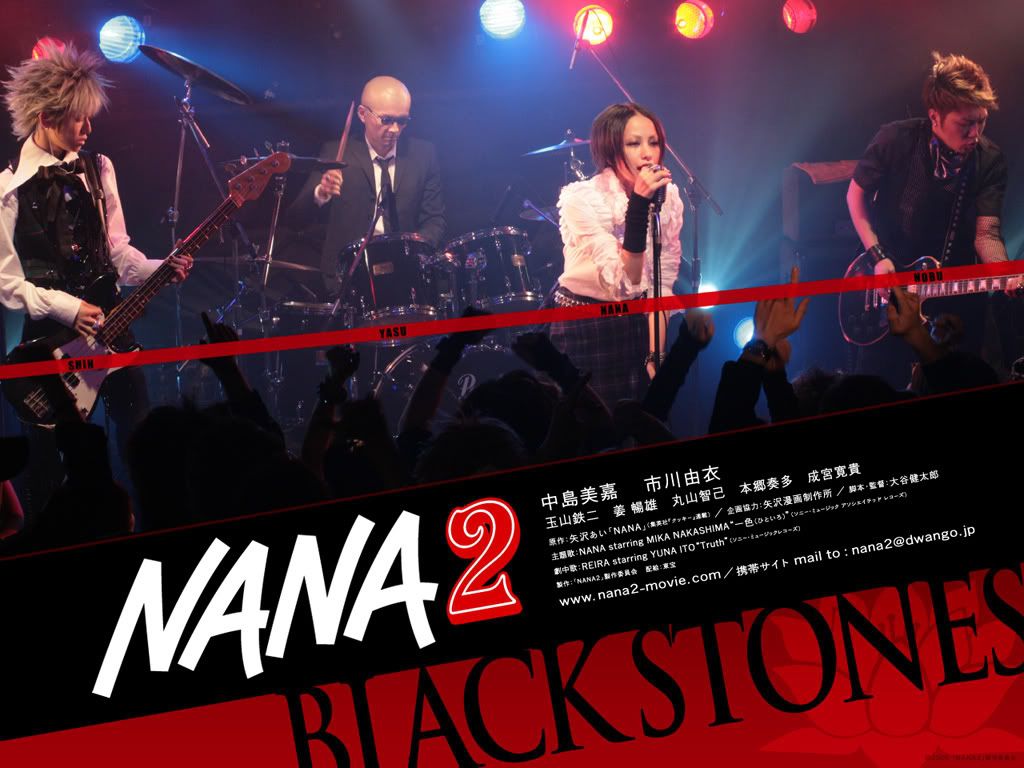 Volume 2 is where the story really gets going, where Yazawa sets up Hachi’s fascination with Nana’s shadowy past. It’s strongly character driven, with Hachi’s manic energy linking her with her namesake, entangling them both in each other’s lives. Things don’t so much happen as Hachi makes them happen, from wheedling her way into her dream apartment with Nana, to finding a job at a hip vintage clothing store, to spending all her money getting set up in Tokyo.
Volume 2 is where the story really gets going, where Yazawa sets up Hachi’s fascination with Nana’s shadowy past. It’s strongly character driven, with Hachi’s manic energy linking her with her namesake, entangling them both in each other’s lives. Things don’t so much happen as Hachi makes them happen, from wheedling her way into her dream apartment with Nana, to finding a job at a hip vintage clothing store, to spending all her money getting set up in Tokyo.
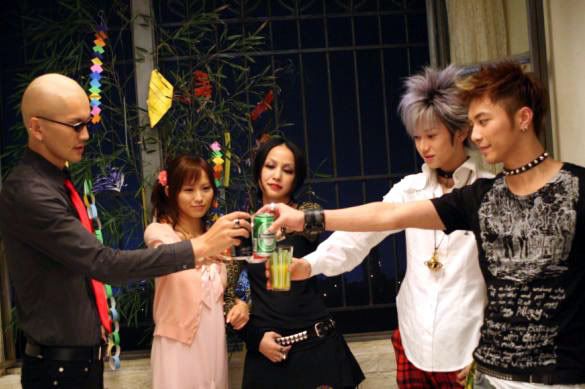 Beyond the addictive charms of the lead story, Yazawa gives us the fun and frivolous “Junko’s Place” backup story, where the Nana cast break the fourth wall while remaining totally in character. Their awareness not only of their existence as fictional comic book characters but also of the cast hierarchy is hilariously meta. As much as I love the narrative, as I accumulated volumes I found myself flipping back to "Junko’s Place" to catch up on Jun and her boyfriend and their little area of the Nana world. Every time Yazawa hints that Junko’s restaurant might close due to lack of business only intensified my obsession. What if Junko’s Place does close? What will she do? What will we do?
Beyond the addictive charms of the lead story, Yazawa gives us the fun and frivolous “Junko’s Place” backup story, where the Nana cast break the fourth wall while remaining totally in character. Their awareness not only of their existence as fictional comic book characters but also of the cast hierarchy is hilariously meta. As much as I love the narrative, as I accumulated volumes I found myself flipping back to "Junko’s Place" to catch up on Jun and her boyfriend and their little area of the Nana world. Every time Yazawa hints that Junko’s restaurant might close due to lack of business only intensified my obsession. What if Junko’s Place does close? What will she do? What will we do?Good god… Nana is a drug. You should have to get a doctor’s okay before buying it. A prescription or something, and your health should be carefully vetted before they hand it out. On the other hand, some stressed out, over-worked mothers here are actually turning over all their parental responsibilities to the Nana comic series and allowing it to raise their children:
PS- Note how the covers actually tell a wordless little story of a day in the lives of the two Nanas. On the cover of volume 1, Nana O wakes first and reads the paper in their cozy little dining alcove, Hachi takes longer to get dressed but appears on volume 2, they have breakfast, go downstairs on volume 3, and on subsequent covers do some shopping, have lunch, ride the trains...
Pretty sneaky, Yazawa Ai!
"Nana volume 1:" A Japanese Comic Review!
 Nana vol. 1
Nana vol. 1Publisher: Shojo Beat/Viz Media
Writer/Artist: Yazawa Ai
English Adaptation: Allison Wolfe
Translation: Goto Koji
When my Nana
Stands next to your Nana
I can’t define Nana
When it’s not Nana
I’ve got two Nanas
I’ve got two Nanas
And they go tweet tweet tweet tweet tweet like little birds…
Yeah, I could’ve gone with something even lamer, like a David Letterman flopping at the Oscars riff: “Nana, meet Nana. Nana, Nana. Nana, Nana.” But no, I felt like breaking out some Talking Heads. It’s more appropriate.
My mental dysfunctions aside, I have gathered you here today, dearly beloved, to talk about Nana, the lively Japanese comic series where two young women both named Nana wind up cohabiting apartment 707 while chasing their dreams, living their lives and occasionally eating Jackson Burgers.
But before we get to all the fun stuff that makes up the actual story, we have to travel westward along the Tokkaido Line rails for volume 1, the two-part prelude where Nana Komatsu (eventually she’ll be known as Hachi, but for now she’s still just Nana K) has just graduated high school and broken up with her married boyfriend. Acting on the advice of her best friend Jun, this Nana decides to stop objectifying men. Good idea, because the result is something approximating true love with guy-pal Shoji. But how can it last when Jun, her laid-back boyfriend Kyosuke and Shoji are all moving to Tokyo to attend art college, with Nana stuck in their Podunk hometown?
In another city, another Nana is also being left behind. Lead singer of Blast (short for Black Stones), Nana Osaki has had a hard-luck life; not as bad as orphan Annie’s but still pretty rocky. She’s a high school dropout thanks to a trumped-up prostitution scandal, thinks she killed her grandmother and now her band is falling apart.
Despite sharing given names, the Nanas are definitely a study in contrasts. The first Nana is scatterbrained and immature, barely capable of making it through the day without falling madly and foolishly in love with some unwitting guy, forever exasperating the more together Jun with her silliness and seeming amorality. The other Nana is a Vivienne Westwood-loving rocker who hides her insecurity behind tough talk and an evil demeanor.
Writer/artist Yazawa Ai smartly avoids making Nana K a victim of anything other than her own unrealistic romantic expectations. It would’ve been easy for her to make Nana’s businessman lover a real creep. Not that she lets him off the hook, but Yazawa divides the blame roughly between the two. She still keeps the majority of our sympathies focused on Nana; after all, the story is named after her.
Yazawa also avoids some of the more annoying stereotypes Japanese comics are rife with. She gives her characters depth. Nana K is flighty and immature, but also blisteringly self-aware and capable of personal growth. Nana O is tough and cynical, but also vulnerable. Even the supporting characters have a welcome richness. Best friend Jun is sensible but often frustrated with Nana, while Shoji shows flashes of a temper and a love of drinking that keep him from being merely the pretty boy love interest. And Kyosuke? It’s all good to him.
Yazawa’s artwork is quite appealing but not mindblowingly cute like something by Takashi Rumiko. While it’s certainly not realism, it is fairly natural at times, even with those Japanese visual tropes- you know, stock depictions of facial expressions and emotions, the happiness face with half-circle eyes, no nose and a big triangular mouth. Lots of tone effects that have more meaning for Japanese readers than they do for ignorant me. Yazawa’s figures have spindly, elongated bodies that make them look fashionable, elegant even. They're romanticized, sophisticated.
Let's take a break and look at an image from the wildly popular Nana film adaptation, starring the exquisitely cast Nakashima Mika as Nana O, and the almost-as-well-cast Miyazaki Aoi as Nana K:
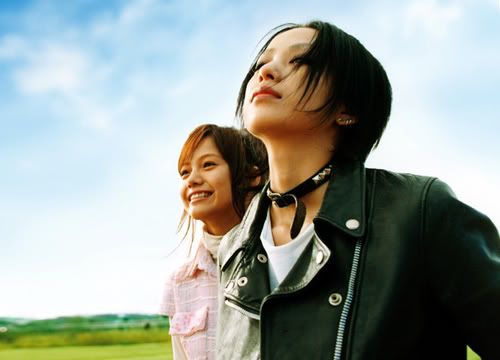 Actually, they might be equally perfectly cast, but since the film isn't available here in Japan with English subtitles (you can order the region 1 DVD from Amazon.com, though), I haven't been able to see it. But from the publicity stills I've seen and the trailers I've watched, Nakashima looks as if she somehow stepped off Yazawa's drawing board directly into our world.
Actually, they might be equally perfectly cast, but since the film isn't available here in Japan with English subtitles (you can order the region 1 DVD from Amazon.com, though), I haven't been able to see it. But from the publicity stills I've seen and the trailers I've watched, Nakashima looks as if she somehow stepped off Yazawa's drawing board directly into our world.
Now, back to the review...
Backgrounds are sparse, and Yazawa relies heavily on dot-screened photos for outside environs, so occasionally the reader will recognize a real-world location, as in the scene where Nana K and Shoji walk through a neon-lit cityscape that could possibly be Shinjuku. The end result is even more focus on the characters. Which is fine, because Nana is such a character-driven narrative. What’s really interesting about the art is Yazawa’s mastery of costuming; I’m guessing the stretched fashion art figure work isn’t accidental. All her characters are very outfit-specific, from Nana K’s girly-girl late 90s combos complete with platform-soled shoes (the story opens in 1999, after all) to Nana O’s Vivienne Westwood gear.
Oh yeah, the movie version. It was such a huge hit the Japanese staff at my job were briefly Nanafied. I don't mean they dressed like Nana O (although I would've enjoyed that a lot!). But during the film's initial run, their break room suddenly became absolutely littered with copies of Nana! In Japanese, of course. Here's a photobook. When a movie comes out in Japan- much like in America- it's accompanied by tons of ancillary merchandise. My favorites are always the "making of" books, because they come loaded with photos:
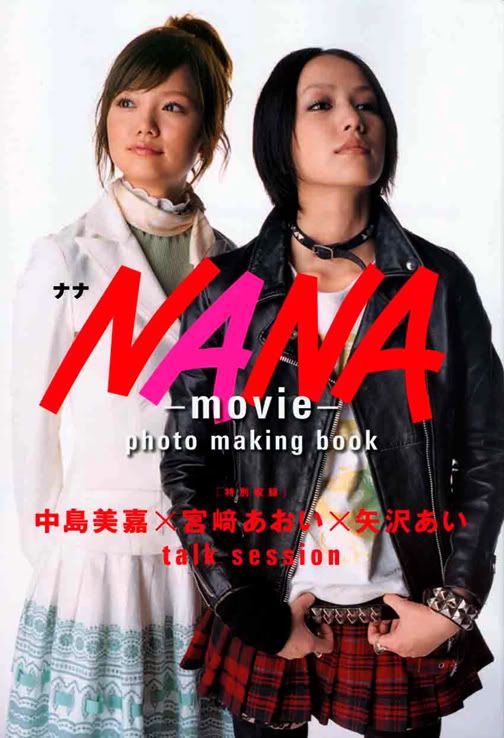 End of digression.
End of digression.
Obviously, Japanese punk is somewhat different than Western punk, at least the modern iteration. To me, Nana O is more goth than punk, although she's heavy on the punk flourishes. Seems like a more purist punk would be a little less name-brand conscious. If anything, I’d put her more in the visual-kei subculture, further evidence of which is provided later in the series when her gosu-rori superfan Misato shows up. Visual-kei is a gothic pop/rock music style beloved by the gosu-rori tribe, and features androgynous or downright feminine-looking guys and… well… Nana-looking girls. Look up bands like Glay, L’Arc-en-Ciel and Dir en grey to see what I’m yakking about.
Still, if you were interested in dressing exactly like either Nana, Yazawa provides enough visual reference to make it easy. To turn yourself into Nana O, all you have to do is hit Hysteric Glamour or some of the other “punk” shops along Takeshita-dori in Harajuku where the Vivienne stuff is readily available; for Nana K, one of the suburban malls will do…
Actually, the Shitoro Aeon mall in my city of Hamamatsu would be perfect for any would-be Nana K’s out there. I could see her shopping there for looks to impress, outfits she thinks of as sophisticated or mature that end up showing just how naïve she really is about love and life in general.
Her hometown actually reminds me a lot of the first place I lived here in Japan, a small, blue collar city called Toyohashi, in Aichi prefecture- Japan’s industrial heartland, where the cyberpunk unreality of the Tokyo skyline is almost as foreign or distant as it is to your average American. In these places life is more workaday, less magical. Bisected by an ugly gash of train and shinkansen tracks, hugged to the north by mountains and to the south by the polluted Pacific, Toyohashi is a pleasant and unpretentious city of just plain folks (Japanese variety), the kind of place where cute but average girls like Nana K dream of escaping to a better life via marriage or work in Tokyo as a flight attendant or fashion store employee.
Hey, I forgot to tell you- not only did Nana inspire a hit film and its hit sequel, but also an animated series. As you can see from this still, the character design draws heavily on Yazawa's artwork. Fittingly so:
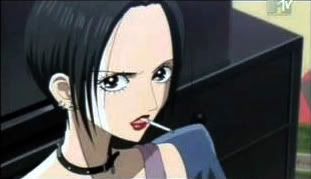
That Nana O has the characteristic Yazawa angular look. In the stylistic home of large eyes, Yazawa's are standouts. She imbues them with an emotive intensity not generally found in the work of other Japanese artists.
That was the final aside. I promise.
Although certain story clues seem to place Nana K’s little hometown as further north than Toyohashi, these smaller cities are pretty much the same, nowhere places lying along the shinkansen lines between somewhere places like Osaka and Tokyo. You see them flashing by, identical stations, McDonald’s and Jusco department stores.
You pass them by, hoping for a better life, a romantic dream come true… until you’re something of a Nana yourself.
Nana is compulsively readable, with characters getting themselves into situations that Yazawa Ai devilishly leaves a-cliffhangin'. She's a wicked one, all right. The translation is nicely done- a few usages like "It's piss cold" and "What a sarcastic bastard" give it a bit of a spicy kick. Congratulations...
Highly Recommended
But...
Warning: The Food and Drug Administration has determined that Nana is one of the most addictive substances known on earth. Buy this book at your own risk and don’t tell the DEA I told you to. A friend of mine bought me this in Kyoto and I’ve been obsessed with the Nanas and all their friends for about two weeks now. Run! For the love of God, run away from Nana before it hooks you and you end up like me, turning tricks in Kabuki-cho to feed the habit!
I’m so ashamed…
Sunday, May 18, 2008
Remain Calm: Tokyo Is Experiencing a Burst of Puffy-Mania!
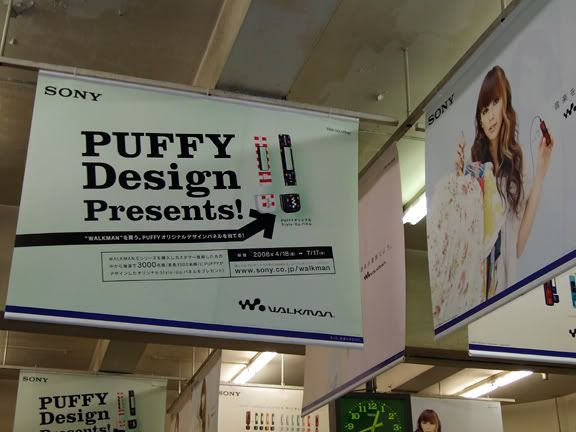 It's a Sony ad campaign starring the unstoppable J-Pop/Rock duo Puffy (better known in the U.S. as Puffy AmiYumi). It's for a new line of Puffy-approved Walkman music players, perfect for listening to their new album:
It's a Sony ad campaign starring the unstoppable J-Pop/Rock duo Puffy (better known in the U.S. as Puffy AmiYumi). It's for a new line of Puffy-approved Walkman music players, perfect for listening to their new album: Remember when the Walkman was a cassette player you clipped to your belt? Now it's a tiny little thing you can hold in the palm of your hand. Here's Ami:
Remember when the Walkman was a cassette player you clipped to your belt? Now it's a tiny little thing you can hold in the palm of your hand. Here's Ami: These were (as you can see) hanging from the rafters in Ikebukuro, but there were even larger versions at eye-level on the walls of Shibuya Station. I... er... forgot to take photos of them. But I did take a shot of this in Shibuya:
These were (as you can see) hanging from the rafters in Ikebukuro, but there were even larger versions at eye-level on the walls of Shibuya Station. I... er... forgot to take photos of them. But I did take a shot of this in Shibuya: It's Yumi and Ami again, this time with tiny leafy stems sprouting from their heads as they drink Kagome vegetable juice. It's healthy stuff!
It's Yumi and Ami again, this time with tiny leafy stems sprouting from their heads as they drink Kagome vegetable juice. It's healthy stuff!You know I'm a huge fan of avant garde sounds like Boredoms, OOIOO and Melt-Banana and the straight up rock of groups like Go!Go!7188 and Electric Eel Shock. More punk and noise than pop. Puffy have a more rock-based sound than most bigtime acts here, and their songs tend to be tasty and hook-laden, imminently listenable in the way only the best pop confections can be, from the Beach Boys, the Beatles, early Jackson 5, ABBA, Kristy MacColl, the GoGo's... There's just something joyful about a good guitar-based pop/rock (or, if you prefer, rock/pop) song.
All that aside, how exactly did a hardboiled noise-loving person like myself become a Puffy fan? Easy.
On a 6 month sabbatical while waiting for my new job to come through, I started watching the Hi Hi PuffyAmiYumi cartoon stateside. It didn't take long for me to hip to the fact that the live action bumpers starring Puffy themselves were infinitely more colorful, entertaining and energetic than the cartoon portions (cute designs and outstanding voice acting let down by weak scripts) of the show!
Ami and Yumi have an undeniable charisma. Whether mock-arguing over which is better, Tokyo or Osaka, giving karaoke instructions (it's ka-ra-oh-kay, not "carryoki") or dining on giant bowls of ramen with outrageous toppings, they were funnier, brighter and more charming than anything else on Cartoon Network or most American TV at the time, and were constantly reminding me of just how much I'd enjoyed the previous year and a half in Japan, and how much I was looking forward to returning.
And their songs are just so catchy!
Okay, now you know a little bit about Puffy. The rest is up to you!
Saturday, May 17, 2008
And Here's Something Unusual: a Dixieland Hanami, April 2008!
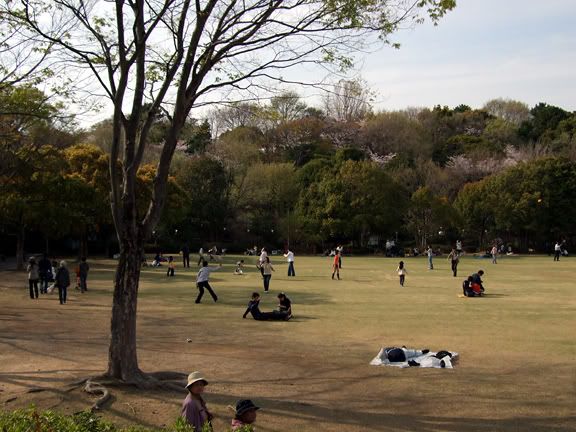 Lanterns are strung in the trees so as night falls, you can still see the blossoms in the mellow light. In the old days they used some sort of oil lamps, but today they use electricity. It's still lovely at twilight.
Lanterns are strung in the trees so as night falls, you can still see the blossoms in the mellow light. In the old days they used some sort of oil lamps, but today they use electricity. It's still lovely at twilight.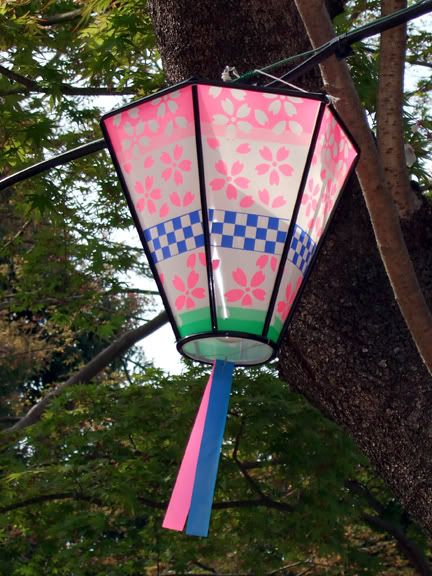 Happy groups of people arrive early to lay claim to the prime real estate all across the grassy lawns, then spread out blue plastic tarps- used by the homeless around the bridges in Shinagawa and Kawasaki for housing- and then tuck into more food than any small group can safely eat. Sushi rolls, bread, sandwich meat, yakitori, potato chips, potato salad, pizza, onigiri, mixed nuts, sliced or baby carrots... and in our case, french fries from McDonald's for some reason. Big cans of Asahi Super Dry and Kirin and Sapporo Draft One, lemony chuhai, sake, perhaps even wines of various types, green tea, bottled water, sodas.
Happy groups of people arrive early to lay claim to the prime real estate all across the grassy lawns, then spread out blue plastic tarps- used by the homeless around the bridges in Shinagawa and Kawasaki for housing- and then tuck into more food than any small group can safely eat. Sushi rolls, bread, sandwich meat, yakitori, potato chips, potato salad, pizza, onigiri, mixed nuts, sliced or baby carrots... and in our case, french fries from McDonald's for some reason. Big cans of Asahi Super Dry and Kirin and Sapporo Draft One, lemony chuhai, sake, perhaps even wines of various types, green tea, bottled water, sodas.Eat, drink, walk around the castle gardens, play some soccer or a little pepper. And one group in particular began to jump and wail:
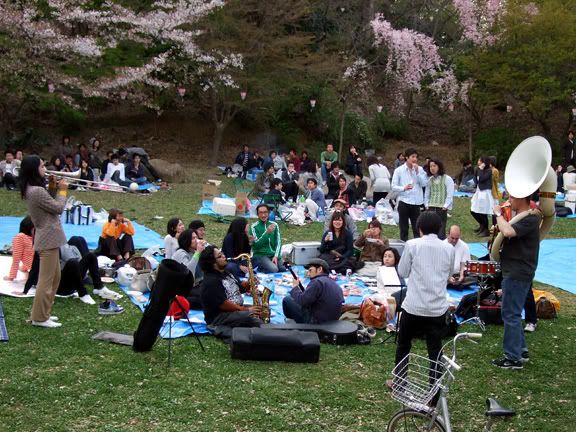
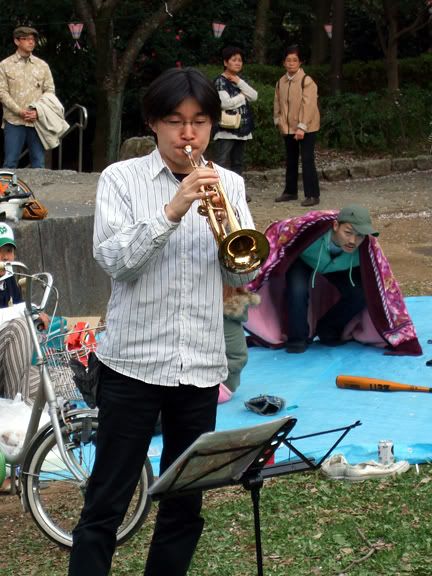 Some people like to nap in the sun, like this stunned young dude:
Some people like to nap in the sun, like this stunned young dude:There. Now you've vicariously enjoyed a hanami..
Tuesday, May 13, 2008
Saw an Old Guy Get Busted Last Night...
The tall one was obviously a store manager. The detective in me identified him by his Lawson uniform, an aqua and white striped smock with a plastic name badge. These badges are rarely helpful to me because the names are almost always in kanji. He was standing next to a shorter man, older and tan, with wavy dark hair. Standing closely the way only lovers, best friends or mortal enemies do.
The older guy was saying something quietly but angrily, emphatically. The Lawson man replied calmly but no less forcefully. They weren't making a huge scene, but to the customers coming and going it was obvious something was going on, something unpleasant. The other store employee stood behind the counter, near enough to make a move in case things got physical.
And they sort of did. The older guy made at least one move to leave, but the Lawson man grabbed his sleeve and held him in place. I feel certain the older guy was saying something along the lines of, "Did you really call the police? I'm just going to leave."
And the Lawson man replied something like, "You're not going anywhere, jack. Just stand right where you are."
I made my selections while trying to listen but not be too obvious about it. I know enough Japanese to get the gist of things, so I thought it might be educational and entertaining. I was definitely impressed with how calm all three men were. No shouting, no fits of anger. And it all happened to the incongruous store soundtrack of a man and child singing a happy little ditty about how fun it is to shop at Lawson Station.
The old guy quieted down, stood next to the door as people came and went. A very stylish young office worker came in with a worried look on her face. But the old guy didn't make a run for it. I suppose at that point he was resigned to his fate.
I paid for my food and as I turned to leave, the cops showed up. A man and a woman, both wearing the dark blue livery of Hamamatsu's finest. Police uniforms in Japan tend to make the officers look more like understated theater ushers. Thick polyester jackets, ties, radios clipped to their epaulets, gun belts. The men wear stiff-visored hats- universal copwear- but the women don these natty little caps in a design considered quite stylish for flight attendants in the 1960s.
The woman cop and I made eye contact as I turned to the door. For a moment we were both at a loss. I had this idea she thought for just a second that I was the reason they were there and I was going to be some kind of gaijin troublemaker. But then again, maybe I was just projecting.
"Sumimasen," I said and she moved to let me exit. I towered over both these cops, which is a novel experience in itself. But the Lawson guy... he was pretty big. Didn't look like he was going to accept any more nonsense that night.
As I put my bag in my bicycle basket, I could hear the discussion begin. He said-he said. I have no way of knowing what the old guy did in the store. My guess is shoplifting, but it could've been anything. He didn't seem drunk; no swaying, no babbling. Maybe he exposed himself. I once saw a guy masturbating away outside a Lawson in Toyohashi, right across from the train station, letting it all hang out for everyone to enjoy. Probably not nearly as much as he was. So I know these things happen. Who knows, maybe there's a class of perverts who get off on convenience stores.
You don't generally see things like this in stores here. You can walk in with a big bag, no one bats an eye. I feel both trusted and trustworthy. But then, there are people who no doubt take advantage of this social contract between store and customer. There always are, Japan or wherever.
